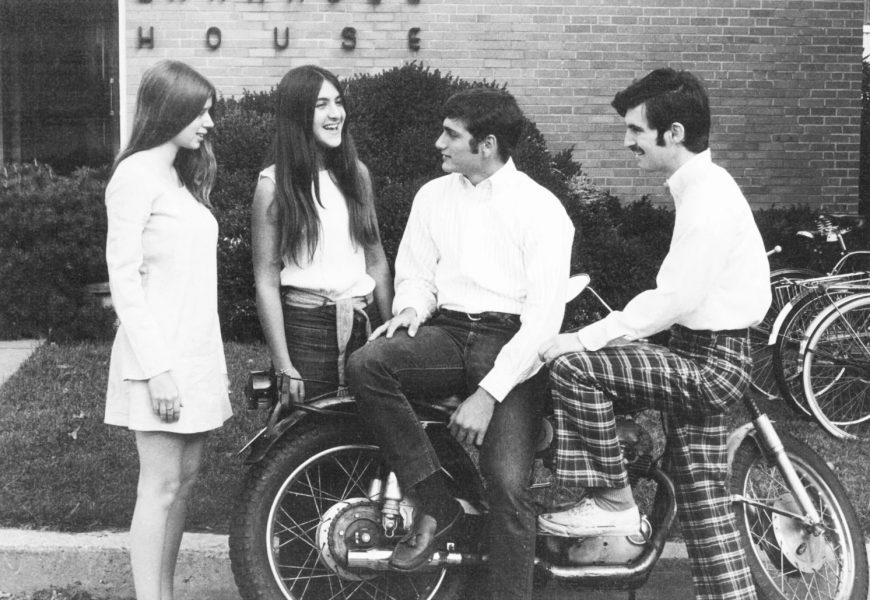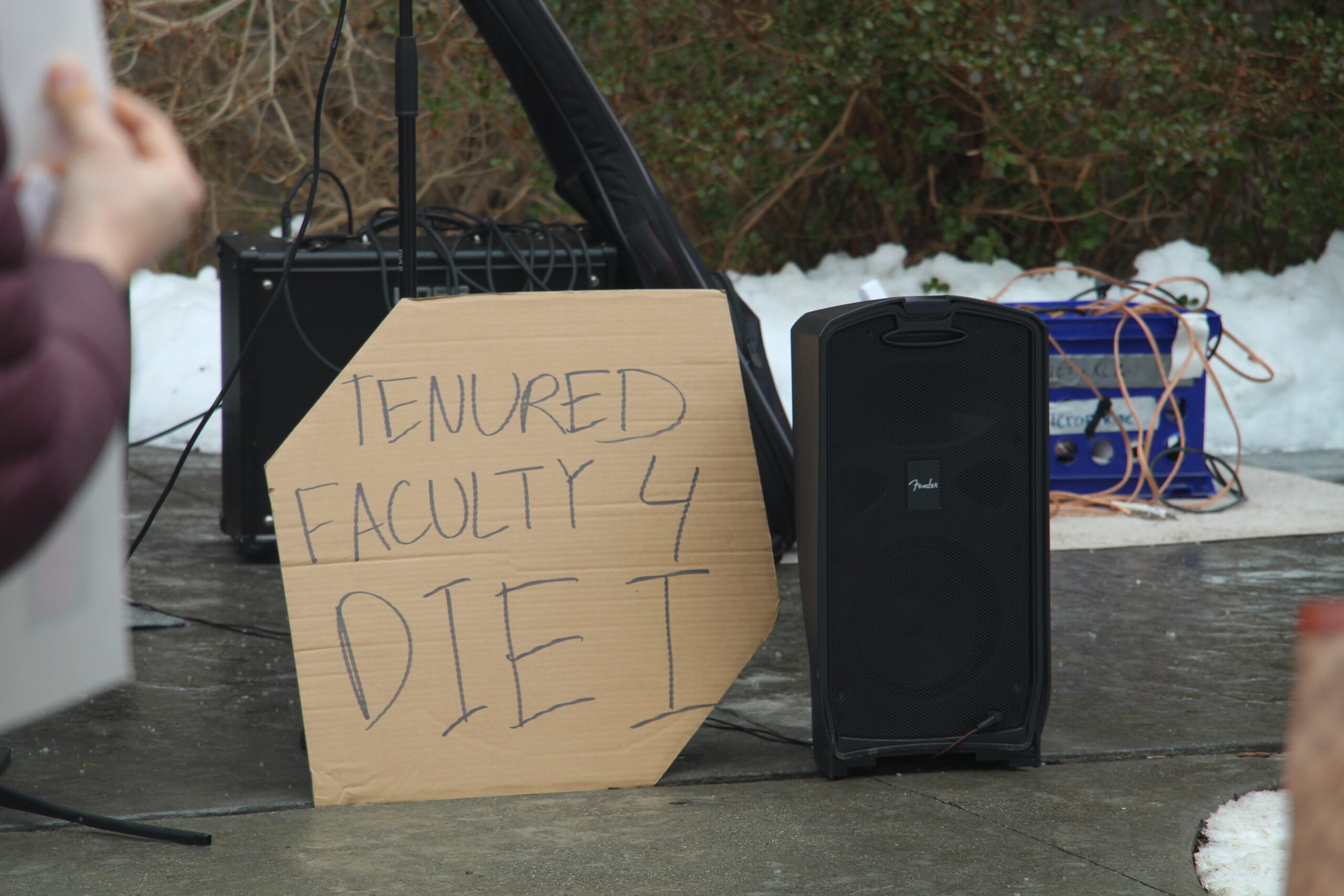Fifty years ago in 1969, Connecticut College went co-ed. On Nov. 21, 2019, Rodi York ‘66 and Laurie Cameron ‘69 spoke about this transitional time at Conn in an “Alumni Panel Discussion on Co-Education,” which was hosted by Professor Trina Learned’s First Year Seminar titled “Past, Present, and Future @ CT College.” York was an art history major and loves museums. She worked at Mystic Seaport for 35 years and has been retired for 10 years now. After graduating from Conn, Cameron went to graduate school at Columbia University and went on to be a modern dancer in New York City. She taught dance at Conn for a bit before going to teach at Pomona College, and finally at the Naval War College in Newport, Rhode Island.
York shared some “rules” that were established at the college during her time as a student: no cars were allowed until second-semester senior year, no students were permitted to go to Bank Street, and students were required to attend monthly chapel services. Although not all students were religious, there was a noticeable religious presence on campus. The chaplains were influential in bringing students together in non-denominational meetings to discuss current events and issues. Students took comprehensive final exams after winter break (could you even imagine?), and exams were pass/fail. If you failed, then you could not graduate. The chapel bell would ring if a whole class passed their exams. For freshman and sophomore year, there was a requirement to take some form of physical education. The options included archery, fencing, swimming, and “pre-ski,” which entailed walking and jogging in the arboretum. Cro was used as the athletic center and all students were required to pass a swim test prior to meeting their physical education requirement. Students wore skirts to dinner, which was a sit-down setting, where you were served a single plate of food. On Fridays, however, you could wear slacks or jeans because it was a more casual buffet-style dinner. Apparently, the most memorable dish was “Mystery Mocha,” which is some kind of chocolate-y dessert. Intriguing, right? Students had to sign-out to go downtown and had to be back by 11 pm, unless you went to a mixer.
At the time, the transition to co-education seemed to be the thing to do. Both Brown University and Yale University had “Co-Education Weeks” in the late 1960s, eventually going co-ed in 1971* and 1969, respectively. It was a time during which much attention was paid to “leadership and the advancement of women,” which the administration at Conn spoke of often.
Not all of the students were thrilled about Conn going co-ed. Some wanted to be at an all-women’s college, but others felt that it was more realistic to have men as peers at the college because women would work alongside men in their careers. Going co-ed also created a more “casual” atmosphere for dating and relationships. Before Conn admitted men, many women would take trains to go on a date with men from other schools. During this time, visiting men were allowed in student’s rooms on Sundays between 1 o’clock pm and 5 o’clock pm. They were signed into the building and the bedroom door was required to remain open.
Cameron and York discussed some of the most memorable historical moments that occurred during their time as students at Conn. In 1963, the USS Thresher, the naval nuclear-powered submarine, went missing. It was reported that 16 officers, 96 enlisted men, and 17 civilian technicians were on the submarine (according to Naval History and Heritage Command). The sadness of the event was felt greatly on campus because of the College’s proximity to the Naval Base in Groton. Later that same year, on Nov. 22, President John F. Kennedy was killed. York recalled being able to hear radios reporting the news anywhere you went on campus that day. Betty Friedan released The Feminine Mystique in 1963, which was a particularly notable at an all women’s college. In 1964, The Beatles appeared on the Ed Sullivan Show. Residents all gathered in their living rooms to watch the band’s debut televised performance in the U.S. When the Vietnam War began, the campus was active in protesting and promoting awareness. The ConnCensus student newspaper protested the war, and students and faculty alike participated in demonstrations. One chemistry professor taught about chemical warfare in class and even protested with students by occupying the main entrance of the college on Mohegan Avenue. York also mentioned the Griswold v. Connecticut case, which went before the Supreme Court in 1965, resulting in the ruling that Connecticut’s ban of contraceptives for married couples violated the right to marital privacy.
To talk on the phone, you would have to wait for other residents to be done on the one or two landline phones available in the house. Papers were handwritten or typewritten. There were not quite as many washing machines. In fact, your sheets would be washed for you — and if you didn’t put the sheets outside of your door to be washed, then you were fined $10. Adjusting to contemporary inflation, that is just short of $70. Pretty steep!
The living rooms (common room) were a lively scene in the 60’s. Cameron and York recalled that there was a house mother in the “complex” and that some residence halls may have had “junior advisors.” The living rooms fostered a communal environment in which the residents, from all four class years, would get together to play bridge and smoke. It was customary to gather in the living room after dinner. Sometimes residents would play a tune for their housemates on the piano. Every Wednesday evening, tea and cookies were delivered to the living rooms. This gathering encouraged students to take a break from their work and to engage socially with their friends and peers.
Though the college is today still predominantly women (62%), the social scene that Cameron and York reminisced about has changed. We do not have weekly tea and the common rooms are used for study, if at all. Is this the result of the change in demographics or simply the passing of time, or maybe both? •
Photo courtesy of Connecticut College Linda Lear Center.










